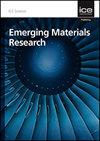Performance enhancement of Sb2Se3 solar cell with IGZO and n-ZnO as electron transport layers
IF 1.2
4区 材料科学
Q4 MATERIALS SCIENCE, MULTIDISCIPLINARY
引用次数: 0
Abstract
A prototype of an antimony (III) selenide (Sb2Se3) solar cell with different electron transport layers (ETLs) was simulated using the Solar Cell Capacitance Simulator (SCAPS) software. The impact of two individual ETLs – namely, indium gallium zinc oxide (IGZO) and n-type zinc oxide (n-ZnO) – was analyzed, and it was found out that n-ZnO was best for the ETL. The n-ZnO, antimony (III) selenide and Indium gallium zinc oxide (IGZO) layers in the newly proposed structure have respective thicknesses of 50, 300 and 20 nm. To achieve the optimum performance of this prototype, the acceptor concentration of copper (II) oxide is taken as 1018 cm−2 and the donor concentration of n-ZnO is taken as 1020 cm−2. The defect densities at antimony (III) selenide and antimony (III) selenide/n-ZnO are taken as 1013 and 1010 cm−2, respectively. They play a crucial part in device performance. With the optimized structure, a maximum power conversion efficiency of up to 31.72% (V OC = 1.148 V, J SC = 48.30 mA/cm2 and fill factor = 88.50%) is obtained with n-ZnO as the ETL. For effective results, the defect densities at both interfaces are taken as 109 cm−2, and maximum efficiency is achieved. Numerical analysis of the proposed structure and study of various parameters such as thickness variation at the absorber layer, series resistance and temperature variation, defect density, metal function and interface density variation were done.以 IGZO 和 n-ZnO 作为电子传输层的 Sb2Se3 太阳能电池的性能提升
利用太阳能电池电容模拟器(SCAPS)软件模拟了具有不同电子传输层(ETL)的硒化锑(III)(Sb2Se3)太阳能电池原型。分析了两种独立 ETL(即铟镓氧化锌(IGZO)和 n 型氧化锌(n-ZnO))的影响,发现 n-ZnO 是最佳的 ETL。在新提出的结构中,n-ZnO、硒化锑(III)和氧化铟镓锌(IGZO)层的厚度分别为 50、300 和 20 纳米。为使原型达到最佳性能,氧化铜(II)的受体浓度取为 1018 cm-2,氧化铟镓锌的供体浓度取为 1020 cm-2。硒化锑(III)和硒化锑(III)/n-ZnO 的缺陷密度分别为 1013 和 1010 cm-2。它们对器件性能起着至关重要的作用。通过优化结构,以 n-ZnO 作为 ETL,可获得高达 31.72% 的最大功率转换效率(V OC = 1.148 V,J SC = 48.30 mA/cm2,填充因子 = 88.50%)。为获得有效结果,两个界面上的缺陷密度均取为 109 cm-2,从而实现了最高效率。对所提出的结构进行了数值分析,并研究了各种参数,如吸收层厚度变化、串联电阻和温度变化、缺陷密度、金属功能和界面密度变化。
本文章由计算机程序翻译,如有差异,请以英文原文为准。
求助全文
约1分钟内获得全文
求助全文
来源期刊

Emerging Materials Research
MATERIALS SCIENCE, MULTIDISCIPLINARY-
CiteScore
4.50
自引率
9.10%
发文量
62
期刊介绍:
Materials Research is constantly evolving and correlations between process, structure, properties and performance which are application specific require expert understanding at the macro-, micro- and nano-scale. The ability to intelligently manipulate material properties and tailor them for desired applications is of constant interest and challenge within universities, national labs and industry.
 求助内容:
求助内容: 应助结果提醒方式:
应助结果提醒方式:


